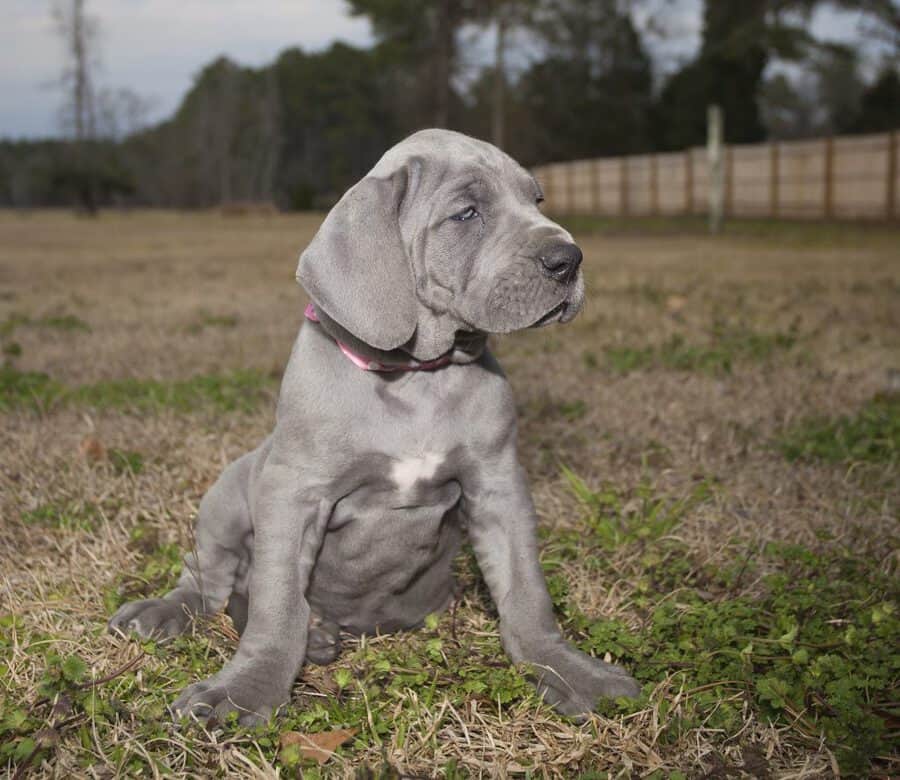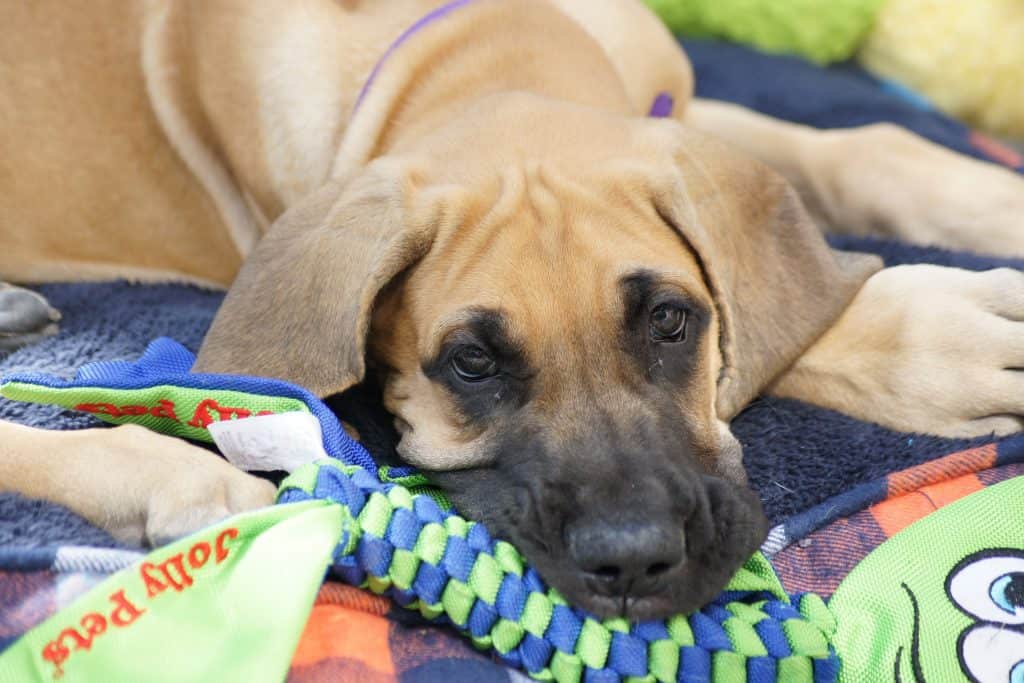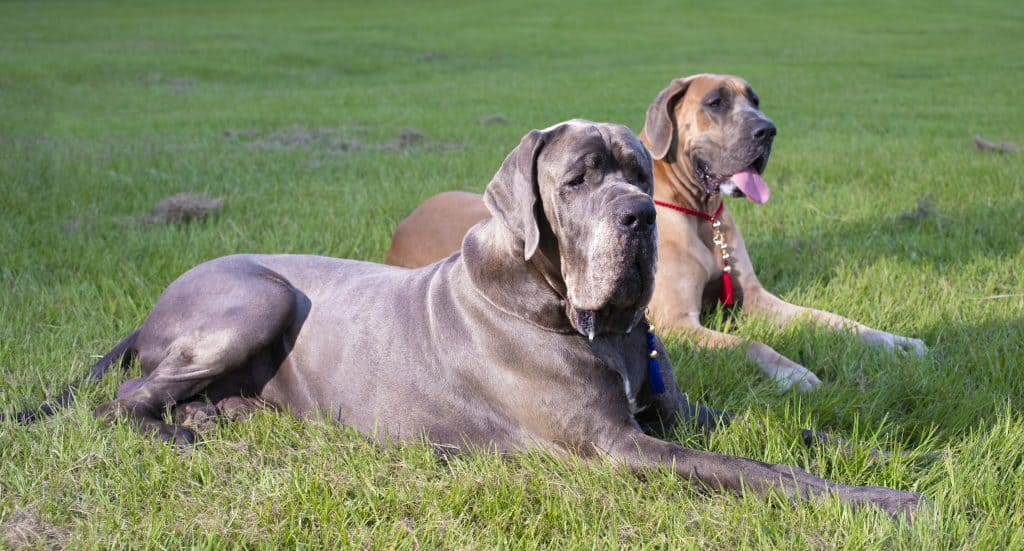Are Great Danes Hypoallergenic? Tips for Families with Allergies.
Great Danes are a great family dog, with a loving temperament and gentle nature about them, who wouldn’t want one! However, there is more to learn than just being a loving dog, and here’s why.
Great Danes are not hypoallergenic dogs. However, they are better than some other breeds of dogs for people with allergies, as they have a shorter coat. However, their coats are thicker, meaning they will shed more in the summer than other months.
In order to learn more about shedding, pet dandruff, and other things that may contribute to one’s allergies, keep reading!
Why Aren’t Great Danes Hypoallergenic?
The word hypoallergenic simply means that the animal that someone has chosen will not cause allergies to anyone around it. Hypoallergenic animals will shed little to nothing at all.
Generally, they will not have dander that will cause the most irritants for those who are allergic to animals, making it easy to maintain and not have to take medications to keep it around.
There is no such thing as a 100% hypoallergenic dog. Why?
Two of the major causes of allergies from pets is their dander and saliva. It’s not just the hair that people have to worry about. About 10% of the U.S. population is allergic to animals, these two major irritants.
It can be difficult to control one’s allergies because dogs shed and leave dander all over the home, which can be difficult to overcome, especially with a large dog that has a longer coat will shed more frequently.
The reason Great Dane’s are not considered hypoallergenic is that they do shed, not necessarily as much, but they do have dander that causes irritants, which bothers most people, and this is because of the breed of dog they are.
Animals that are considered hypoallergenic are not entirely void of shedding and dander, but it’s all in that they don’t as much and don’t have the same reaction as dogs who shed and have incredibly thick coats that they need to shed.
There are two different types of coats, a single or double coat. Dogs that have double coats shed more frequently because they have more hair to lose, especially in the warmer months, because they need to be cooler. Great Danes only have a single coat, which factors into less shedding and makes it easier to maintain.
Great Danes will still shed more in the spring because it’s getting warm, but it is a much easier coat to maintain than others.
It can be difficult to classify dogs as hypoallergenic because all dogs will shed, at least some, but there isn’t as much of a problem from Great Danes because they have a shorter coat, which can be more easily controlled and won’t cause as many allergies as some other breeds of dogs.

What Makes a Dog Hypoallergenic?
There is nothing definite that makes a dog hypoallergenic, because all dogs subsequently shed, which is considered to make a hypoallergenic because they don’t shed or leave as much dander. This is not true, as all dogs will shed, it is based on how much they shed. Considering Great Danes do shed a little, they are not considered hypoallergenic.
There is also saliva that people need to take into account. Personally, I react a little bit when my dog licks my hand. It’s not much, but I do get a rash. And, well, all dogs have saliva. On top of that, some people allergic to urine and all creatures on earth urinate.
EDITOR’S NOTE: If you are looking for a full resource to answer your Great Dane questions, this book is an excellent resource!
Taking this all into consideration, what may be considered a hypoallergenic dog may not be the solution to your family’s problems. Finding a dog that sheds less will vastly improve one’s allergies and will benefit the dog as well.
Purchasing a dog that is considered to be hypoallergenic isn’t always the answer, and should be researched. Depending on how sensitive your family members may be to either the saliva or the dander is what should be done for your family.
Great Danes Shed, How Much?

Great Danes do shed, but not as much as one would think. When looking at the coat of a Great Dane, you will notice that their coat is shorter. The coat is not as thick, which is a huge contributing factor that they will not shed as much as some other breeds of dogs.
With all dogs, they lose hair playing around, scratching themselves, or whatever else they do as a dog, in which hair will subsequently fall out. Fur grows continually and replaces the old hairs.
New hair will grow in, eventually growing old, and then more new hair will come in. It’s a simple cycle and will continuously happen throughout the dog’s life.
As dogs grow older, they will shed more often, as their coats will become thinner and will fall out more frequently.
When dogs are young, they will rub against things and lick themselves, which can help keep hair and dander to more of a minimum, but with age comes restrictions, as dogs can no longer move the way they once did.
One thing to look for is excessive shedding. Great Danes do shed, which is a part of their process, as everyone sheds hair to make room for new growth, however, if a Great Dane is shedding a lot, there could be something wrong. Some things that come from excessive shedding are health problems.
Some minor things that can contribute to excessive shedding is a poor diet or even that your dog may have allergies. If excessive shedding continues to occur, consult a veterinarian.
There could be serious problems with their digestive tract or even stomach ulcers. It’s important to pay attention to their eating and play habits.
Great Danes will shed most in the spring. However, if you live somewhere that is ALWAYS warm, you might find that your dog sheds more than he or she normally would in a more temperate climate.
Here’s What Contributes to People’s Allergies
Two of the biggest things that come from dogs that will trigger people’s allergies are pet dander and their saliva. Pet dander comes from the animal’s coat, which is something that can’t necessarily be controlled.
Consider this BEFORE purchasing a dog if you know you are allergic to dogs. In regards to dog saliva, some people are allergic to the bacteria in a dogs saliva, which can be problematic.
Great Danes majority have dander allergens, but not necessarily saliva allergens. Dander comes from a dog rubbing against objects to itch itself or also just scratching itself and spreading those particles into the air.
People who are allergic to animals have over-sensitive immune systems, which are triggered by many products of animals. Great Danes mainly contribute dander, but some may be affected by their saliva which is also an irritant.
How to Help Prevent Triggering Allergies
If you are slightly allergic to dogs but are willing to pay the price, there are some things you can do. Loving dogs are totally worth it, believe me!
Bathing
Bathing your Great Dane regularly is a great way to contain hair and prevent it from shedding excessively and frequently.
Your dog can be bathed about every six weeks, depending on the level of activity. Bathing your dog at this frequency, with shampoo that you can find at Walmart, on Amazon, or any other place that sells dog shampoo is really good for their hair and skin.
Their skin is a little more sensitive than humans, and it is important to take care of their skin to prevent excessive amounts of shedding.
Depending on how often your Great Dane spends it’s time outside is how often you should choose to bathe them. The recommended is once every 6 weeks if necessary, but you can go up to eight weeks without having to bathe them if they spend most of their time inside.
It is also based on your preference if you need to consider limiting their dander more for the needs of those in your household. Whatever is best for the needs of you and your dog is what you should.
You should know that overbathing is a problem though. Bathing too frequently will take away their natural skin oils, leaving their skin itchy and flakey. This might make them rub themselves on the floor or scratch to get some relief, spreading more hair. So.. bathe but don’t over-bathe!
Grooming
Grooming is an essential part of taking care of one’s Great Dane. It can also be very soothing for them and allow them to relax and be cleaned properly so as to help with their dander.
Some recommend that Great Danes be taken to the groomer at least once a month. At the groomer, dogs are able to receive a deep wash, clipped nails, and conditioned so as to help take off any excess dirt they may have acquired over their months of playing and adventure.
When grooming, have someone who isn’t allergic brush your dog, if possible. If not, wear gloves. One really awesome thing that you can/should do for those who have allergies is to brush outside!
This way, the hair that falls out will not be stuck inside. You can run a vacuum gently over your Great Dane to catch any loose hair before he or she runs out.
Wash Your Hands!
Not only is it important to wash your hands when you leave the bathroom, but it can also vastly improve one’s allergic reactions around animals, especially your Great Dane, if you wash your hands after each pet or playtime, if not frequently.
When petting your Great Dane, and you don’t wash your hands, you can touch your face, either your nose, eyes, or mouth, and get those irritants closer to the places that are irritated by those things, which can make the problem more continuous if not heightened because they get spread more easily.
If you wash your hands after petting, playing, or just frequently, it will help to prevent these from spreading all over and causing you to be miserable after trying to enjoy spending some quality time with your dog.
This is seriously the best thing to do. If you don’t wash your hands in time, you might have to jump in the shower to get itch-free.
Medications
Thankfully, there are dozens of medications out in the public, either over the counter or prescribed, that can be taken that will help lessen the problems that are caused by dander, saliva, and general pet hair.
Some of the over-the-counter antihistamines that can be found at your local Walmart or Walgreens are things such as Zyrtec, Benadryl, Allegra, Claritin, and several others that can be purchased just by walking into the allergy aisle. They can come in pill form, nasal sprays, liquids, gels, and even eye drops.
They help to block the histamines that are causing the problems that people experience from allergies, which makes it more enjoyable to spend time around your Great Dane.
In order to maintain that healthy immune system and block those problems is to take antihistamines regularly. Some people may experience a sense of becoming immune to their antihistamines, but that is not true.
The reason some may be experiencing this is that they are not taking their medication regularly, which is essential for blocking the problems. Set a reminder to take your medication regularly in order to keep a healthy immune system and become less irritated.
Something else to also consider is weekly allergy shots. The great part about these is that they last an entire week, of course, and if taken regularly will deaden the symptoms that are experienced from pet hair and dander, and will make it easier to tolerate and overcome, in a sense.
If it is really bad, and you can tell that it is affecting you more frequently and more severely, consider consulting a doctor for prescription medications.
Contain the Hair

Bedrooms Off Limits
One of the major factors the help contribute to the problem of being severely allergic to your favorite cuddle buddy is allowing them into your bed.
Dogs shed, that is a guarantee, and they will even scratch themselves in your bed, rub their back to reach an itch, and whatever else dogs may do to release their hair and dander right into your bed, the place you lay in and put your face in, which allows those irritants to get right into your nose and eyes and can make you miserable.
In order to prevent this, simply make the bedroom off-limits. It is relatively easy to teach your Great Dane to stay off of your bed, considering they are tall enough to just stand up and fall into the bed.
Consider keeping your bedroom door closed at all times to give the notion that that is not a place for dogs, which will vastly limit the amount of dog hair and dander that is allowed in your bedroom, which will vastly improve your health.
No Dogs on the Couch
Making the bedroom off-limits is the first step in helping to eliminate the amount of dog hair that you come into contact with, but the couch should definitely be the next place to make a safe space for yourself to not worry as much about animal dander.
Teaching your Great Dane to stay off the couch helps to set boundaries between what is okay and what isn’t, teaching your dog what is good and what isn’t.
Rewarding them for learning how to do both of these things, staying out of the bedroom and off of the couch helps instill good behavior and they learn that it is being a good boy by staying off of the bed and couch, which is beneficial for the relationship between the both of you.
Brush Your Great Dane Regularly
Especially in the spring, Great Danes will shed a lot more than they did through the winter months. In order to help lessen the amount of hair that you will see collecting on the carpet and amongst all of the corners of your home, brush your Great Dane regularly.
Regularly could be every day, every other day, it all depends on how much hair your dog is shedding and how much it is triggering your allergies.
Do not purchase wire brushes, which will scratch your Great Danes body and produce more dander as it rips up the skin, which will produce more dander. It will also pull our hairs that have not come loose or out yet and can hurt your dog.
It is best to purchase a rubber brush that gently pulls out the hair that is gathered along the top of the coat instead of trying to reach under and rip out the hair that isn’t ready. Rubber brushes are definitely more beneficial for your Dane.
Our recommendation is this super awesome glove set, available on Amazon. Again, have someone without allergies do the brushing. But, with this product, you can pet and groom your dog all in one! They are inexpensive and easy to use!
Vacuum Regularly
Not only does washing your hands, preventing your Great Dane to get on certain things that you sit on, help to prevent the amount of dander and hair that you come into contact with, but so does vacuuming.
Watching dust bunnies collect in all kinds of places and get stuck to everything can not only be annoying but can also flare up one’s allergies. Get a powerful vacuum that can get into all of those hard to reach places is beneficial for both pet and owner. Try vacuuming your house once a week and see how that can improve your health.


